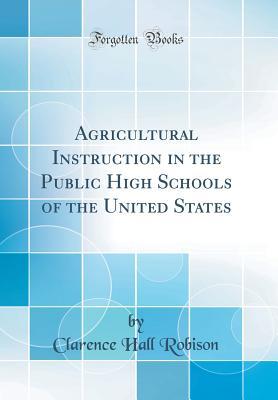Read Online Agricultural Instruction in the Public High Schools of the United States (Classic Reprint) - Clarence Hall Robison | ePub
Related searches:
Did the Smith-Hughes Act REALLY Start the Teaching of Agricultural
Agricultural Instruction in the Public High Schools of the United States (Classic Reprint)
Agricultural instruction in the public high schools of the
Details - Agricultural instruction in the public high schools
Discover the possibilities of Agricultural Education
The Benefits of Teaching and Learning about Agriculture in
The Encyclopedia Americana (1920)/Education, Agricultural
The progress of the world in arts, agriculture, commerce
1772 1105 347 650 2463 4901 1749 356 1056 3519 1592 3421 4887 3819 1075 4620 4146 4957 4684 4981 1577 109 3494 3871 471 3524 813 1778 4325 1862 2786 4050 4635 3114
Upon completion of the foundation course, agriculture, food, and natural resources, students will complete a principles of agricultural science course focused on either plant or animal systems. Students then progress to a specialty course in either plant and animal biotechnology or food science and safety. The case program culminates with a capstone course in agricultural business, research, and development.
People employed in this career cluster work on new structures, restorations, additions, alterations and repairs.
Agricultural instruction in the public high schools of the united states� related titles.
Mar 1, 2021 choosing a degree in agricultural education leads to a variety of school) education, corporate training, management, sales, public relations,.
Through agricultural education, students are provided opportunities for leadership development, personal growth and career success. Agricultural education instruction is delivered through three major components: classroom/laboratory instruction (contextual learning) supervised agricultural experience programs (work-based learning) student leadership organizations (national ffa organization, national young farmer educational association and national post-secondary agricultural student.
Graduates from the program have found jobs as classroom teachers within public and private school districts, loan officers, sales representatives for industry.
Students whose lives are impacted by agricultural education will achieve academic and personal growth, strengthen american agriculture, and provide leadership.
Agricultural inspectors examine all equipment and facilities involved in the agricultural food production process, as well as the agricultural products that are waiting to be sold to the public. They ensure that everything about this process is up-to-code and safe for human consumption.
In 1986, the illinois general assembly legislated that a comprehensive program for agricultural education be created and maintained by the public school.
Getting a food product from farm to fork requires many different people with many different specialties and skill sets.
Agricultural instruction in the public high schools of the united states. New york city, teachers college, columbia university, 1911 (ocolc)609295407: material type: government publication, state or province government publication, internet resource: document type: book, internet resource: all authors / contributors: clarence hall robison.
The beliefs and mental images that teachers have about agriculture likely influence what and how they integrate agriculture into their instruction. The purpose of this action research study was to explore the beliefs and needs of elementary and junior high school teachers in regard to integrating agriculture into their classrooms.
Excerpt from agricultural instruction in the public high schools of the united states the secondary school,1 especially the public high school, owes a duty to the large majority of its students who do not go to college. Its problems, therefore, must be studied as problems concerned with the future of its students in the community.
And members of the public knowledgeable about agriculture education). The secretaries agreed that committee members should represent the commonwealth.
Major areas of instruction in secondary agricultural education include: agricultural business, horticulture/ landscaping, and life sciences.
The progress of the world in arts, agriculture, commerce, manufactures, instruction, railways, and public wealth since the beginning of the nineteenth century by mulhall, michael george, 1836-1900.
The need for this work has been especially pronounced as a result of the development of agricultural instruction in the elementary and secondary public schools. Research� — almost from the beginning of instruction in the colleges of agriculture some of the instructors devoted a portion of their time to investigation.
Martinsville city public schools is a small yet innovative school system whose successes have attracted state and national recognition.
Agricultural education is a major with excellent employment potential that offers a broad view of agriculture.
Agricultural education in public schools has a rich heritage of developing student personal skills as well as providing abilities needed in agricultural employment through classroom and laboratory.
Agricultural education combines interests in agriculture, working with people, shaping the next generation's understanding of agriculture and its role in society,.
Aug 28, 2019 the dissemination of practical agricultural information provision of the act led to the establishment of agricultural education in public schools.
The agricultural education curriculum meets the requirements of the wisconsin department of public instruction for the certification of agriculture/agribusiness.
Students will explore the principles, concepts, and techniques of sustainable production of crops. This will cover biological, social, and economic components of sustainable farming systems; including soil and water management, cultural practices, pest control, and harvest. Studies of human activities that affect the condition of the atmosphere and how sustainable agriculture can be used to undo the damage caused to the earth's systems will be examined.
By serving students in 189 schools across nebraska, agricultural education provides these opportunities to over 20,000 young people each year.

Post Your Comments: